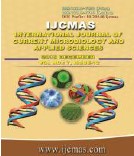


 National Academy of Agricultural Sciences (NAAS)
National Academy of Agricultural Sciences (NAAS)

|
PRINT ISSN : 2319-7692
Online ISSN : 2319-7706 Issues : 12 per year Publisher : Excellent Publishers Email : editorijcmas@gmail.com / submit@ijcmas.com Editor-in-chief: Dr.M.Prakash Index Copernicus ICV 2018: 95.39 NAAS RATING 2020: 5.38 |
A prevalence study of PPR among small ruminants was conducted in five districts (Udaipur, Dungarpur, Rajsamand, Chittorgarh and Banswara) of southern Rajasthan including both vaccinated and unvaccinated flocks of sheep and goats. The overall seroprevalence of PPR virus antibodies in vaccinated small ruminants is 42% with highest prevalence in Chittorgarh (54.95%) and lowest in Banswara (12%). In unvaccinated group, the overall seroprevalence is 42.18% with highest prevalence in Banswara (66.07%) and lowest prevalence in Udaipur district (19.04%). In the case of groups with unknown vaccination status also the highest prevalence was in Banswara district (79.16%) and the lowest prevalence in Dungarpur district (18.18%). The proportion of seropositive animals significantly differs between districts, species and age. There was no statistical difference in the seroprevalence recorded in male (33.96%) compared to that in female (43.79%). The PPR seroprevalence recorded in goat (53.86%) is significantly higher than sheep (20.31%). Among different age groups, animals more than 2 year old showed more seroprevalence (57.39%) compared to 1-2 year age group (44.17%) and less than 1 year old (39.53%). Only 16.5% total population of small ruminants appeared to have protective PPRV specific antibody response i.e. percent inhibition (PI) > 76%). Out of a total of 160 suspected sample (oral and nasal swab) examined with sandwich ELISA, 4 (2.5%) samples were positive for PPR viral antigen. This study showed varying antibody levels in the districts screened reflecting the infection and vaccination profiles of the herds.
 |
 |
 |
 |
 |